Last
updated: 3rd April 2011.
This web site has emphasized the continuity of the Roman Empire from
the 4th century BC to the 15th century AD. Its supposed fall in 476 has
been downplayed: first because New Rome (Constantinople) had already
become the chief city of
the Empire and would remain so for almost a millennium more; second
because at least nominally Rome and Italy remained part of the Empire
until 527; third because within two generations of 476 Rome had been
reconquered by the Empire, and (apart from short lapses) would remain
part of it for another two centuries and more. Despite all of this, it
cannot be denied that from the mid 4th century to the mid 8th century
the Roman Empire in Western Europe declined and fell, then rose again
and gradually fizzled out, only to be reinvented by Charlemagne and
Pope Leo III in 800. In this page I concentrate on this four-century
long decline and fall in the West. It turns out that there are some
remarkable parallels with the dramatic events in the decline and fall
of the Eastern (Byzantine) Empire some seven centuries later. Although
the timings are not precisely the same, both saw a decline, then a
sudden loss of territory, a relatively rapid recovery of much of it,
then another decline and fall, a reconquest, and a final decline ending
in a bang in the East and a whimper in the West. The small maps on the
timelines below illustrate this.


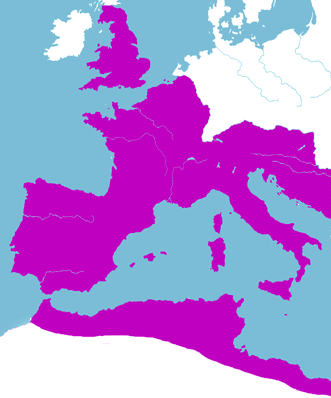
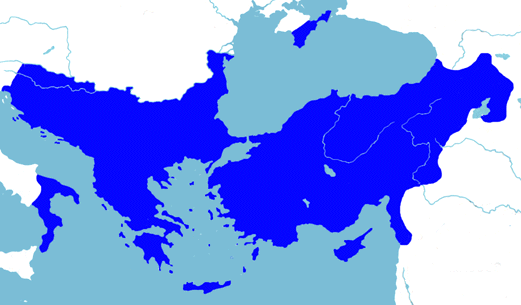
| In 358, Julian was the Caesar of the Western Roman Empire (that is, he was the deputy to the Augustus in Constantinople, who was his uncle Constantius). He had just decisively defeated an attack by the Franks and Allemans on Roman Gaul, thus restoring the Roman frontier to the Rhine and Danube, as it had been for almost a century. Julian became sole Emperor in in 360, and revealed himself as a pagan like the Emperors of old. He also emulated them by deciding to make war upon the old enemy: Persia. | In 1045, the Byzantine Empire under Emperor Constantine IX annexed Ani, completing the reconquest of Armenia. This restored the frontier in the north-east close to where it had been before Julian's campaign in Persia. Although this was a high-water mark for the Byzantine Empire in the east, in the west it was already showing signs of weakness. It had failed to conquer Sicily from the Arabs in 1038-43, and its holdings in Italy were under pressure from Norman adventurers. The schism between the Eastern and Western Churches in 1054 worsened relations with all of the western powers, with dire long-term consequences. |
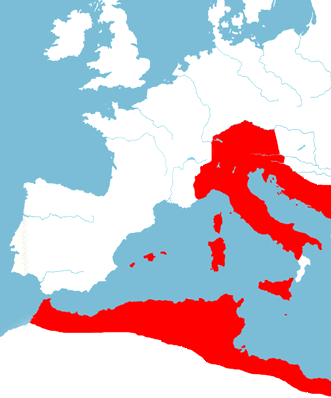
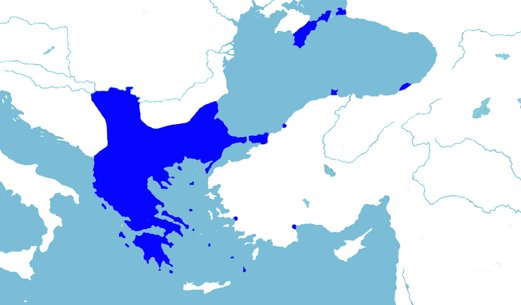
| Julian's Persian campaign was a disaster in which he himself died in 363. An even worse disaster followed in 378 when the Eastern Emperor Valens was killed at Adrianople by the Visigoths who had fled across the Danube from the Huns some years earlier. They continued to menace the Balkans until 401 when they invaded the West. In 410 they sacked Rome, and then occupied Italy's toe, hoping to move to Sicily. Meanwhile, the Sueves, Vandals and other Germans had crossed the Rhine in 406, and the Gallic provinces rebelled under the usurper Constantine from Britain. | Under weak rulers, the Byzantine Empire came under attack in the 1060s from the Normans in Italy and the Seljuk Turks in Armenia. In 1071 the former finished off Byzantine Italy, and the latter routed the last great Byzantine army led by Emperor Romanes Diogenes at Manzikurt in Armenia. His successors refused to meet the Turks in the field and as a result virtually the whole of Asia Minor, and even some Aegean islands, had fallen to the Seljuk Sultanate by 1091. Croatia was lost in 1074, and then Serbia. Even Greece was invaded by the Normans from 1080 to 1083, and Paradunavum (south of the Danube) was lost to the Pechenegs in 1076. In 1090 the governors of Crete and Cyprus rebelled. The new Emperor of 1091, Alexius I Comnenus, faced a desperate situation. |
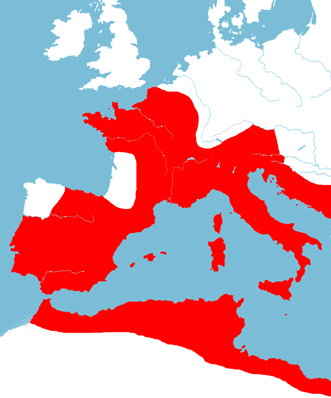
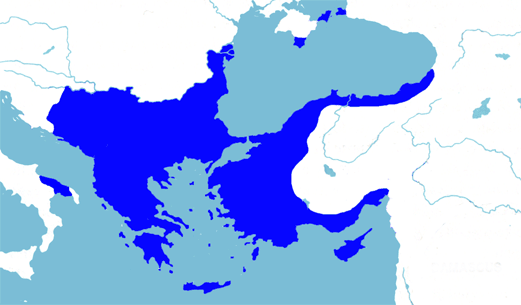
| Constantine and various other rebels were defeated by 411. However Britain was never recovered, and Spain was still being ravaged by Sueves and Vandals. The Emperor Honorius persuaded the Visigoths to leave Italy and in 418 were given a new home in Aquitaine in return for restoring most of Spain to the Empire. Thus in just 10 years, the bulk of the Western Empire had been recovered. But the employment of the Visigoths as federates revealed the true weakness of the Western Empire: it could no longer field a Roman army sufficient to defend its citizens. | Similarly to the situation of the Roman Empire
after 410,
the Byzantine Empire managed to recover much of its lost territories
within
10 years of the nadir of 1091. But it also required external
assistance.
Having recovered Crete, Cyprus, the Aegean and Paradunavum in 1092, and
Serbia in 1094, Alexius felt ready to take on the Turks. He appealed to
the Pope to help raise an army from western Christendom to drive back
the
infidel. The resulting first crusade of 1097 went far beyond what he
expected.
As the crusaders swept across Asia minor on their way to Jerusalem,
Alexius
garrisoned the liberated towns as best he could with his limited army.
His son John II and grandson Manuel I made further gains in Anatolia.
In 1155, in alliance with the Pope, he launched an invasion of the
Norman Kingdom in southern Italy. In 1156 he recaptured Silicia
(south-east Anatolia) from the Armenians. |
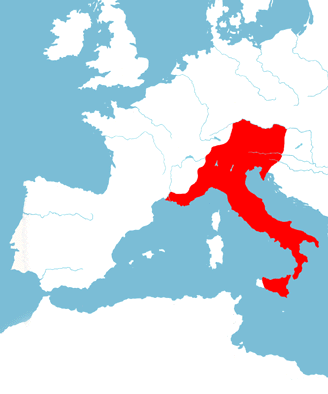

| From 425 to 454 the Western Roman Empire was dominated by the general Aetius, whose strategy was that only Italy and Gaul were vital to the Empire. In 451 Atilla the Hun invaded Gaul. Aetius defeated him with a patchwork army of which the largest contingents were Franks, Visigoths and (for the last time on this scale), Romans. But he had already lost Africa to the Vandals and most of Spain to the Sueves. He was assassinated in 454, and this led to the second sack of Rome, by the Vandals, in 455. After this, the short-lived Emperors lost more and more territory to Germanic kingdoms, and more and more power to Germanic generals. By 475 the new child Emperor Romulus ruled only Italy and Provence, while his predecessor Nepos was ousted to Dalmatia. | Manuel's Italian adventure collapsed in 1156. He later made further gains against Hungary, but these too were expensive and short-lived. The Empire's financial problems at his death in 1180 were exacerbated by his incompetent and ephemeral successors. Serbia and Bulgaria had gained independence by 1187. In 1190, Cyprus, once again in rebellion, was conquered by Richard Plantagenet in the Third Crusade. The Venetians, who had been badly treated by Manuel, saw their chance for revenge in the Fourth Crusade. They had agreed to transport the Crusaders, but required a huge payment of 85 000 silver marks. Then they cunningly argued for making a diversion to Constantinople where, in return for restoring the ousted Emperor Isaac II Angelus to the throne, the Crusaders would receive 200 000 marks (so said Isaac's son Alexius) -- more than enough to pay the Venetians. In 1203 they did the job, but Isaac and Alexius could raise only half the money (partly because his Uncle, another Alexius, was in effective control of Thrace). As the Crusaders grew impatient, yet another Alexius (great great grandson of Alexius I Comnenus) seized control of northern Anatolia in 1204. |

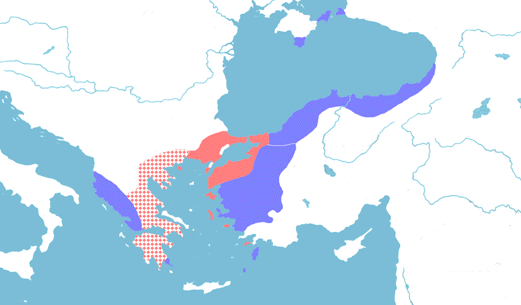
| In 476 Romulus was deposed by his Magister Militum, Odovacer. The latter, being of Germanic origin, could not wear the Purple himself. But unlike his predecessors, he did not set up a new puppet Emperor. Instead, he sent the Imperial Regalia to Constantinople, saying that one Emperor was all that was needed, and that he would be King of Italy, governing in the name of the Eastern Emperor Zeno. His realm is thus shown as light blue in the above. Also shown are two other remnants of the Western Empire (in light red): the realm of Syagrius in Gaul, who styled himself King of the Romans, and that of the former Emperor Nepos in Dalmatia. | In early 1204 Isaac II and Alexius IV were overthrown by yet one more Alexius who became Alexius V. He was unable to placate the Crusaders and Venetians, and in April 1204, they attacked and captured Constantinople. The Empire fell apart at the seams. The Westerners had agreed to split the Empire as follows: 1/4 would become a new Latin Empire (light red), headed by Baldwin (a Crusader) as Emperor in Constantinople; 3/8 would become Crusader states, vassals to the new Empire (light red stippled), and 3/8 would go to the Venetians. As the map above shows, the Westerners managed to grab rather less than half of the Empire. Some fell to the Serbs, Bulgars and Turks. But by 1208 three large successor states had been set up on the peripheries: The Despotate of Epirus to the West, the Empire of Nicaea to the East, and the Empire of Trebizond to the North-East. These are shown in light blue. |
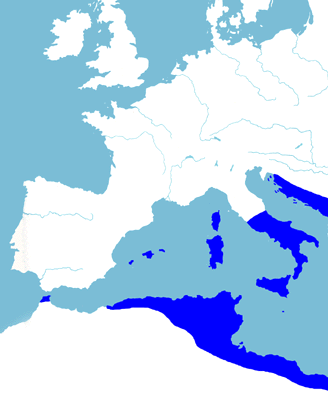
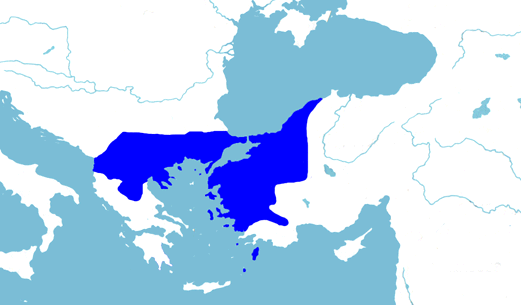
| Nepos was assassinated in 480, probably on Odovacer's orders, and his realm annexed to the Kingdom of Italy. Zeno then recognized Odovacer as Patrician, but he did not trust his ambitions, and in 488 encouraged the Ostrogoths to invade Italy. Under their King Theodoric they defeated and killed Odovacer in 493. Meanwhile, Syagrius' realm had been annexed by the Franks in 486. Theodoric died in 526, and the next year Justinian became Emperor, with ambitions to reconquer the West. His brilliant general Belisarius recaptured Africa from the Vandals in 533 with an army of just 18 000. In 535 he was sent to Italy with less than half that number, and advanced to retake Rome in 536, 60 years after Odovacer's coup. | Again paralleling events of some seven centuries earlier, Constantinople remained in the control of the usurpers for almost 60 years. But in this case, it was the remnants of the old Empire that managed the reconquest. Within 20 years of its birth, most of the Latin Empire had been retaken by Epirus and Nicaea, but suspicion between them prevented either from taking Constantinople. In 1230 the Despotate of Epirus was badly defeated by the Bulgarians, and the Empire of Nicaea became the clear leader. Over the following decades it expanded at the expense of Epirus, Bulgaria, and the Latins in Europe. However it was not until 1261 that the Byzantines, having good intelligence of the absence of most of the Latin army, were able to retake Constantinople in a swift operation at night. |
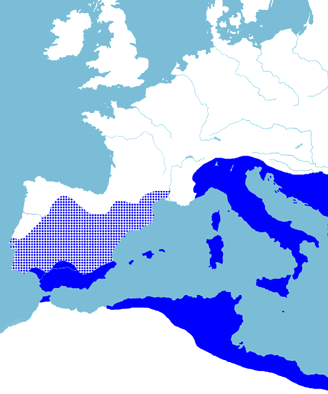
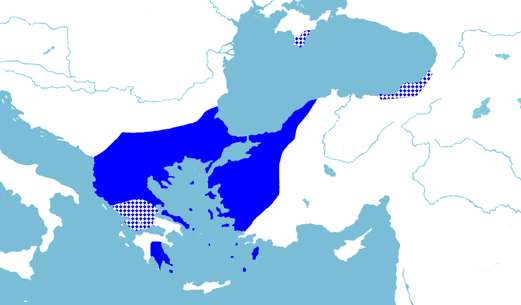
| By
540 Belisarius
had largely confined the Ostrogoths to north of the Po. If he had
followed his Emperor's orders, there would have been peace based on the
status quo, leaving the Ostrogoth kingdom as a buffer state in northern
Italy. If he had accepted the offer of allegiance by the
Ostrogoths, he could have become a new Roman Emperor in the West. He
did neither. Belisarius tricked the Ostrogoths into surrendering, but
was recalled to take command of the Eastern armies against a
Persian invasion. The Ostrogoths rallied, then
plague struck. In 546 the Ostrogoths regained Rome, and it changed
hands
again in 547, 550 and 552 when it was finally retaken for the Empire by
the elderly eunuch general Narses. In the same year, Justinian sent
another army to help one side in a civil war in Spain. By 563 the
ruinous wars in the west were finally over, and two new prefectures,
Italy and Africa (including southern Spain, Sardinia and Corsica) had
been established, to match the two Eastern prefectures. |
The new Emperor
Michael VIII Palaeologus ruled over a state more powerful than any of
its neighbours (partly thanks to the Mongol invasion of the Near East
and Eastern Europe). He wasted no time in expanding his Empire at the
expense of Epirus, Bulgaria, Serbia, Venice (in the Aegean) and the
Latin Principality of Achea (in Southern Greece). He survived an
invasion by Charles of Anjou (who held Southern Italy). By 1288 all
of the remaining Greek states had recognized Michael's successor
(Andronicus II) as their overlord. The Empire looked in better shape
than it had for almost a century, but
financially it was still vulnerable, and in Anatolia, the Turks were
already whittling away at its territories. |
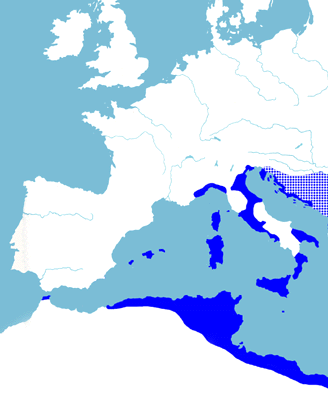
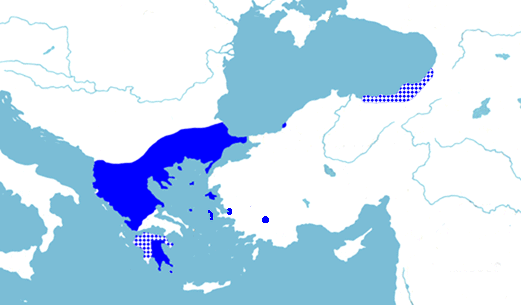
| Just three years
after Justinian's death, the Lombards invaded Italy. By 605 they had
taken most of the country. However, the Empire kept Rome and Ravenna
and the land linking them, preventing the formation of a unified
Lombard kingdom. At this time war with Persia flared up again, and this
time the Empire found itself fighting for its life. Under the Emperor
Heraclius, whose father had been governor of Africa, it ultimately
triumphed in 629. Around this time the Visigothic reconquest of Southern Spain, begun in
575, was completed. But with Heraclius finally able to turn his
attention to Europe, Illyria and the Balkans (which since Justinian's
time had been raided, and then settled by Slavic peoples) were at least
nominally reincorporated into the Empire. |
Again paralleling
events seven centuries earlier, the restored Empire began to fall apart
just three years after its peak. The Turkish penetration in Anatolia
grew worse, Epirus threw off its allegiance, and Serbia invaded.
In a foolish attempt to save money, Andronicus disbanded the navy and
most of the army. He then hired Western mercenaries, the Catalans, in
1303. These were excellent soldiers who threw back the Turks, but when
their exorbitant demands for payment could not be met, they ravaged the
Balkans for several years before taking over the Latin Duchy of Athens
in 1311. By this time, almost all of the Empire's territory in Anatolia
had been abandoned to the Turks, much of it to the nascent Ottoman
Emirate in the North-West. After this, the Empire's rate of decline
slackened. In 1340 Andronicus III (grandson of Andronicus II) was able
finally to annex Epirus outright. Following this, the Latin
Principality of Achea accepted the Byzantine Emperor as its suzerain.
Trebizond too became a vassal once more, as Andronicus' daughter Irene
seized power there on the death of her husband. |
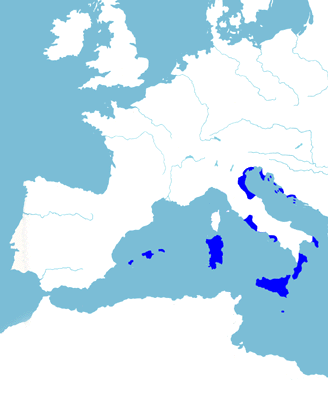
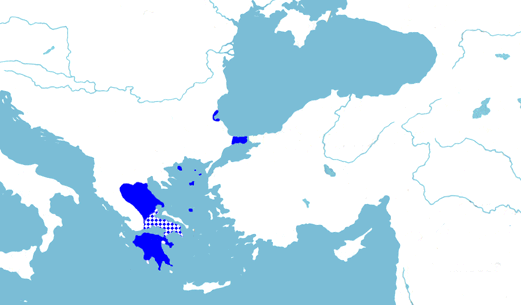
| Unfortunately
Heraclius had no opportunity to continue his restoration of the Empire,
as from 636 it had to defend itself against an even more formidable
enemy in the East: the Arabs. By 646 all that was left of the Empire in
the East was Anatolia and some scraps of the Balkans. The Empire in the
West, despite the continuing encroachments of the Lombards, became
proportionally more important; Heraclius grandson Constans spent his
last five years (663-668) in Italy and Sicily. But even the West was not safe
from the Arabs. In 665 they invaded Africa. Carthage, the second city
in the West, fell in 696, was retaken in 697 and finally fell in 698.
In 738, the Lombards finally took Ravenna, the Imperial headquarters
for the Exarchate of Ravenna which included Rome. The last successful
action by Imperial troops in the Exarchate was to retake Ravenna in
740. But Rome was already effectively independent under its Popes.
After Ravenna fell for the final time in 751, Pope Zachary sought the
protection of Pepin, King of the Franks. His nomination (in defiance of
the Emperor's authority) of Pepin as Patrician of the Romans in 754
would lead in less than 50 years to a New Empire in the West. That year
(754) is as good a marker as any for the end of the Old Empire. |
Just as the future was looking brighter (if not brilliant) for the Byzantine Empire, Andronicus III died in 1341. He was succeeded by his nine-year-old son John V, and civil war soon broke out over who was to be his regent. By the time it ended in 1347, both Bulgaria and Serbia had made gains at the expense of the Empire, the latter expanding to the Aegean Sea and cutting the Empire's territory in two. That same year the Black Death arrived, devastating the Empire's mainly urban population. Civil war broke out again in 1351. By 1354 the Serb Emperor Dushan had pushed his conquests all the way to the Duchy of Athens and the Ottoman Emirate had gained its first foothold in Europe, at Gallipoli. The Serbian Empire broke up on Dushan's death in 1355, but the Byzantine Empire was too weak to retake much of it. Meanwhile, Genoa and Venice fought over the Byzantine islands, and the Ottoman Turks relentlessly expanded into the Balkans. In 1387, the Turks took Thessalonica, the second city of the Empire, and by 1402 only Constantinople, a few Aegean islands, and Morea in the South were left. But in 1403 Thessalonica and some other lands were restored following the crushing defeat of the Ottoman Sultan by Timur the Lame. The Ottoman attacks soon resumed, however, and in 1430 Thessalonica, whose defence had been left to the Venetians since 1423, finally fell. Surprisingly, the Despotate of Morea was expanding at this time, and swallowed up the Latin Principality of Achea in 1432. It was from here that the Empire's last successful military action was launched in 1444: an invasion of the Ottoman Empire in conjunction with a last Crusade of Serbs, Hungarians and Venetians. The Byzantine army forced the Duchy of Athens to submit and occupied Thessaly in 1445. But the next year they were defeated by the Ottomans (who had also defeated the Crusaders) and chased back into the Morea. The end of the Empire followed in 1453 when the 1000-year-old land walls of Constantinople were breached for the first time, by Turkish cannon. |
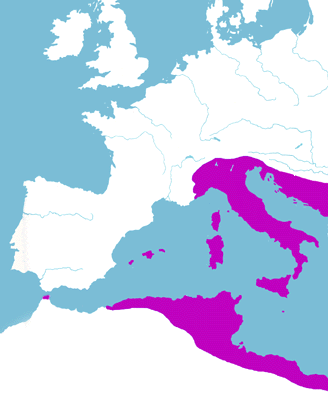
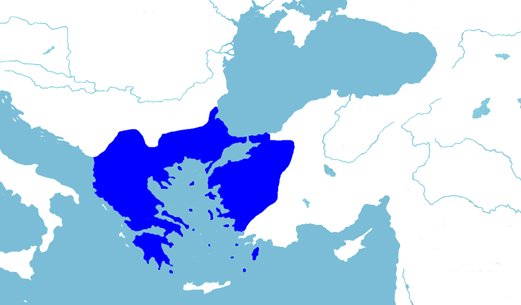
| The preceding maps
illustrated the dramatic ups and downs of the
Roman Empire's decline over four centuries: the Empire in the West from
358 to 754, and the Byzantine Empire from
1045 to 1453. This map summarizes those periods by showing the areas
that
were in the respective Empires for most of the preceding nine maps. The
only surprising thing is the integrity of the two territories.
In the case of the Byzantine Empire, this is only barely achieved,
by counting vassal territories with a weighting of a half. |